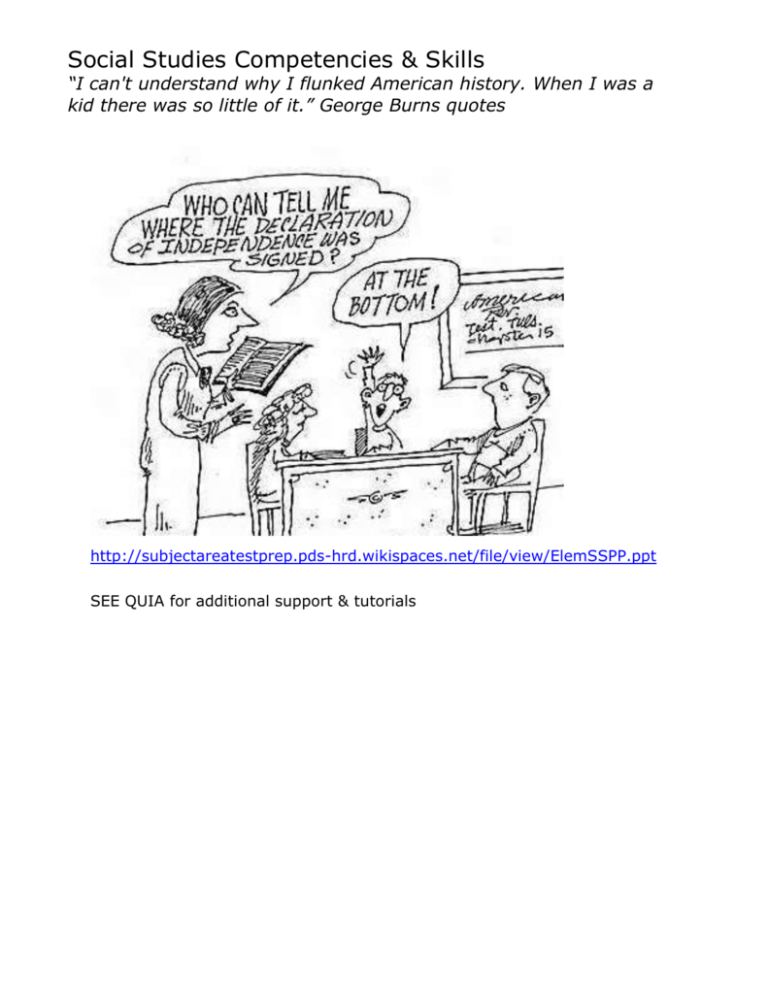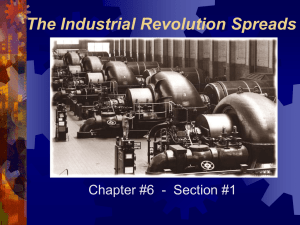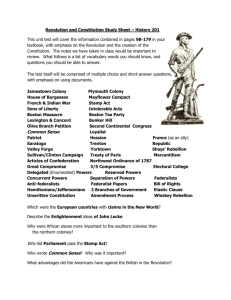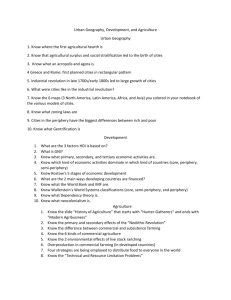Social Studies - Broward County Public Schools
advertisement

Social Studies Competencies & Skills “I can't understand why I flunked American history. When I was a kid there was so little of it.” George Burns quotes http://subjectareatestprep.pds-hrd.wikispaces.net/file/view/ElemSSPP.ppt SEE QUIA for additional support & tutorials 13 Knowledge of time, continuity, and change (history) Four stages of cognitive development (sensorimotor stage, preoperational stage, concrete operational stage, formal observational stage) SS knowledge results from analysis of cause-and-effect relationships; it is in formal operations stage. 1. Identify major historical events that are related by cause and effect. Beginnings of civilization to 1620 Colonization and settlement (1585-1763) Revolution and the new nation (1754-1815) Expansion and reform (1801-1861) Civil War and Reconstruction (1850-1877) Development of the industrial United States (1870-1900) Emergence of modern America (1890-1930) Great Depression and World War II (1929-1945) Postwar United States (1945-1970) Contemporary United States (1968-present) 2. Evaluate examples of primary source documents for historical perspective. The Library of Congress has on-line access to documents from Declaration of Independence and the Constitution to recordings and photos of the Great Depression. 3. Identify cultural contributions and technological developments of Africa; the Americas; Asia, including the Middle East; and Europe. 4. Relate physical and human geographic factors to major historical events and movements. 5. Identify significant historical leaders and events that have influenced Eastern and Western civilizations. Prehistory divided into 3 periods; Paleolithic, or Old Stone Age Mesolithic , or Middle Stone Age Neolithic, or New Stone Age Writing develops between 4000 and 30000 BCE and marks end of prehistoric period. Ancient and Medieval Times Mesopotamia (4,000-2,000) Egypt (5,000-2685BCE) Palestine and the Hebrews (1,700-539 BCE) Greece (800-500 BCE) The Classical Age (569-322 BCE) Rome (753-44 BCE) The Roman Empire (27-395 CE) The Byzantine Empire (408-1453 CE) Islamic Civilization in the Middle Ages (570-1258 CE) Fuedalism in Japan (300 CE-1868) Chinese and Indian Empires (1500-211 BCE) Buddha African Kingdoms and Cultures Scholasticism Late Middle Ages and the Renaissance The Black Death Literature, Art, and Scholarship Leonardo da Vinci (1452-1519) The Reformation Martin Luther (1483-1546) John Calvin (1509-1564) The Thirty year’s War (1618-1648) Explorations and Conquests (1394-1460) Revolution and the New World Order The Scientific Revolution John Locke (1632-1704) The Enlightenment’s Effect on Society Jean-Jacques Rousseau (1712-1778) The French Revolution (1793-1794) Louis XVI and Marie Antoinette The Era of Napoleon Battle of Waterloo in 1815 The Industrial Revolution (1750-1848) Socialism Karl Marx (1818-1883) Friedrich Engels (1820-1895) The Communist Manifesto Das Kapital Marxism 6. Identify the causes and consequences of exploration, settlement, and growth. Beginnings of European Exploration Leif Eriksson Prince Henry the Navigator Technological Innovations Aiding in Exploration Compass from Chinese Pole Star Astrolabe Main Elements of European Exploration Ferdinand and Isabella Christopher Columbus European Contact with the Americans Amerigo Vespucci Vasco da Gama Ferdinand Magellan Spanish Settlements in the New World Effects of European-American Contact 7. Identify individuals and events that have influenced economic, social, and political institutions in the United States. European Settlement and Development in North America John Cabot Henry Hudson Sir Walter Raleigh Roanoke Colonization: The Jamestown Settlement Captain John Smith Powhatan Pocahontas Thomas Gates Thomas West John Rolfe Edwin Sandy Growth of the Slave Trade Salem Witch Trials Religion in the Colonies and the Great Awakening Jonathan Edwards Scientific Revolution Copernicus Benjamin Franklin Cotton Mather The American Revolution The Coming of the American Revolution Sugar Act (1764) Stamp Act (1765) Tea Act (1773) Thomas Hutchinson; Boston Tea Party Coercive Acts (1774); First Congressional Congress (1774) The War For Independence Paul Revere William Dawes Minutemen George Washing ton King George III Declaration of Independence (July 4, 1776) Washington crosses Delaware River and strikes at Trenton. Washington defeats British at Princeton The Creation of New Governments The Federal Era John Adams Bill of Rights Alexander Hamilton (1757-1804) Thomas Jefferson and James Madison (1751-1836) Alien Act and Sedition Act The Jefferson Era Thomas Jefferson and Aaron Burr The War of 1812 James Madison Mississippi Valley The Monroe Doctrine (1823) President James Monroe The Marshall Court John Marshall Marbury vs. Madison (1803) Gibbons vs. Ogden (1824) The Missouri Compromise (1819) Jacksonian Democracy (1767-1845) The Indian Removal Act of 1830 Trial of Tears The National Bank The Antislavery Act (1833) The Role of Minorities Sectional Conflict and the Cause of the Civil War The Crisis of 1850 David Wilmot and the Wilmot Proviso The Kansas-Nebraska Act Stephen A Douglas The Dred Scott Decision Dred Scott, Missouri slave (1857) The Election of 1860 The Secession Crisis Jefferson Davis (1808-1889) Civil War and Reconstitution Hostilities Begin Major Robert Anderson General P.G.T. Beauregard Manifest Destiny and Westward Expansion The Mexican War James Polk and John Slidell (1795-1849) The Homestead Act and the Morrill Land Grant Act (1862) The Emanicipation Proclamation Northern Victory Andrew Johnson President Abraham Lincoln General William Sherman General Robert E. Lee Ulysses S. Grant John Wilkes Booth Reconstitution Freedman’s Bureau Civil Rights Act President Andrew Johnson The Fifteenth Amendment (1868) Ulysses S. Grant for president Industrialism, War, and the Progressive Era The Great Depression and the New Deal WWII The New Frontier, Vietnam, and Social Upheaval’Watergate, Carter and the New Conservatism 8. Identify immigration and settlement patterns that have shaped the history of the United States. The Alien Act and the Sedition Act (1700s) The Indian Removal Act (1830) Trial of Tears National Advancement of Colored People (1909) Industrial Workers of the World (1905-1924) Literacy test for Immigrants and the Emergency Quota Act William J. Simmons and the Ku Klux Klan 9. Identify how various cultures contributed to the unique social, cultural, economic, and political features of Florida. Florida’s History Ponce de Leon Hernando de Soto Spanish exploration Spanish and French fueds James Moore Osceola, Seminole war hero Twenty-seventh state in 1845 Slavery Henry Flagler and Henry Plant Florida During the Great Depression Postwar Immigration and Migration K 1st 2nd 3rd 4th 5th Abraham Lincoln (M) celebrate (M) change * (M) ancestor (M) artifact (M) ancestor ancient (M) adapt ancestor airlift aviation (M) America (M) artist (M) arts change * (M) Christopher Columbus (M) history* (M) holiday (M) inventor * (M) printing press (M) religion (M) timeline (M) colony (M) custom (M) history (M) holiday M immigrant (M) landmark (M) motto (M) archeology (M)* artifact (M) century (M) climate (M) communicati on (M) (M)* artifact (M) aviation (M) climate (M) drought (M) extinct glacier climograph evidence expedition hydroelectri c dam jazz legend (M)* George Washington (M) history * (M) inventor * (M) Martin Luther King, Jr. (M) past (M) pioneer (M) settler (M) space exploration (M) compass (M) crusades cuneiform (M) decade (M) disaster folktale (M)* gateway hieroglyphics history (M)* humid tropical climate (M) hurricane precipitation (M) satellite (M)* storm technology (M) massacre migration missile origin (M) prejudice quarter scurvy tepee terrorism theory Pledge of invention temperature transcontine Allegiance (M) scientist (M) science Thanksgiving (M) today (M) tomorrow (M) tools (M) (M)* legend (M)* literature middle ages millennium monsoon mummy myth (M) (M) tornado (M) ntal railroad yesterday (M) papyrus pollution (M) population (M) renaissance satellite (M) sequence tall tale (M) transcontinen tal transportatio n (M)* slave (M) 14 Knowledge of people, places, and environment (geography) 1. Identify the five themes of geography, including the specific terms for each theme. PLACE: names of continents, countries, cities, as well as field of political science LOCATION: absolute and relative HUMAN-ENVIRONMENTAL INTERACTION MOVEMENT AND CONNECTIONS REGIONS, PATTERNS, AND PROCESSES: identify, climatic, economic, political and cultural patterns within regions 2. Interpret maps and other graphic representations and identify tools and technologies to acquire, process, and report information from a spatial perspective. Study: globe, equator, Antarctic Circle, Arctic Pole, Prime Meridian, International Dateline, North Pole, South Pole, meridians, parallels, the Great Circle Route, and time zones 3. Identify the factors that influence the selection of a location for a specific activity. Absolute location: longitude and latitude Relative location: identify relationships between or among places and people 4. Identify the relationship between natural physical processes and the environment. Physical geography: locating and describing according to physical features 5. Interpret statistics that show how places differ in their human and physical characteristics. Cultural geography: relationship between place and human/animal relationships, deliberate or natural 6. Identify how conditions of the past, such as wealth and poverty, land tenure, exploitation, colonialism, and independence, affect present human characteristics of places. Physical factors and cultural factors are related Change is a constant People modify the environment to suit their changing needs and wants 7. Identify ways in which people adapt to an environment through the production and use of clothing, food, and shelter. Environment can affect the way people live, but people can change the environment to meet their wants and needs. Jobs have a profound effect on the environment. Water and air pollution. 8. Identify how tools and technology affect the environment. Techniques in each era that improved the lives of people: tools and technology, shelters, means to create fire. 9. Identify physical, cultural, economic, and political reasons for the movement of people in the world, nation, or state. Economic reasons Cultural reasons Physical reasons Political reasons 10. Identify how transportation and communication networks contribute to the level of economic development in different regions. Economics is study of society’s choices among a limited amount of resources to attain the highest practical satisfaction. Allocation of scarce resources among competing ends. Advances in communication Convenient transportation 11. Compare and contrast major regions of the world. Equator divides Northern and Southern Hemispheres Eastern and Western Hemispheres Land masses and continents K 1st 2nd 3rd 4th 5th address * address capital (M) acropolis abolitionist archaeologist bar graph (M) Broward cause (M) bar graph (M) (M)* bridge continent (M) desert * (M) earth forest* (M) globe (M) home (M) island calendar skills (M) coast (M) country * (M) desert *(M) diagram direction (M) citizen (M) city (M) communication community (M) Congress (M) country (M) effect freedom (M) border boundary (M) canal causeway cardinal directions city-state coast aquifer archeologist (M) astronaut bay cape classify compare & arid (M) barrio bonanza borderlands broker buffer ceremonies (M) lake * (M) land (M) map *(M) mountain (M) neighbor neighborhood distance (M) factory (M) farm (M) Florida forest (M) harbor government (M) group independence (M) invention colony (M) compass rose conquistador continent custom (M) delta contrast continent (M)* continent shelf culture (M) class concentration camp culture dictator homesteaders (M) ocean * (M) planet hill * (M) lake * (M) map* (M) judge law (M) lawmaker (M) desert (M)* distance scale equator (M) descendant diverse elevation (M) hostage hub longhouse river *(M) school * (M) United States (M) water world (M) world map map key * mountain (M) ocean * (M) pictograph (M) plain * (M) leader (M) mayor (M) monument neighborhood (M) prediction president (M) flow chart (M) founder (M) geography (M)* ghost town (M) gladiator equator (M)* estuary habitat harbor (M)* hemisphere (M)* indentured mercenary (M) metropolitan (M) minuteman mission noble region (M) resources river * (M) school * (M) seasons (M) shore state * (M) symbol (M) rule (M) shelter (M) taxes (M) globe (M)* grid (M) harbor (M)* hemisphere (M) heritage immigrant(M) intermediate directions landform (M) servant (M) inlet interpreter line graph lines of latitude (M)* metropolitan mountain range (M)* nomad nomad * northwest passage open range pilgrim (M) presidio proprietor province (M)* refinery relocation lines of panhandle camp longitude (M) location (M) manor (M) map (M) mediator missionary (M) mountain peninsula plantation (M) prime meridian (M) refugee relative rural reservation separatist (M) skyscraper tenement range (M) ocean (M)* peninsula physical geography (M) savanna (M) sinkhole suburb (M)* swamp tributary urban pictograph (M) plateau wetlands (M) port (M)* province (M)* pyramid (M) rain forest (M) rapids reservoir riverbank route rural (M) scribe settlement (M) silt (M) society (M) source suburb (M) symbol tepee timeline valley 15 Knowledge of government and the citizen (government and civics) 1. Identify the structure, functions, and purposes of government. Definitions Government: agency for regulating the activity for people. Carries out decisions of the political system or the decisions of the ruler. Political system: organizations and processes that contribute to the decision making process Structure Confederation Federal Unitary Authoritarian Parliamentary Presidential Functions Political functions to maintain order within territories Legal functions Economic functions Social functions including civil rights, religion, and education Purposes: myriad ideologies and definitions; protect people’s rights and preserve justice Communism Conservatism Liberalism Democracy 2. Demonstrate knowledge of the rights and responsibilities of a citizen in the world, nation, state, and/or community. Right to due process Right to fair and speedy trial Protection from unlawful search and seizure Right to avoid self-incrimination Values include life, liberty and pursuit of happiness Rule of law Separation of powers Representative government Checks and balances Individual rights Freedom of religion Federalism Limited government Civilian control of the military 3. Identify major concepts of the U.S. Constitution and other historical documents. Historical Documents Articles of Confederation Magna Carta Petition of Right Bill of Rights Crisis in Establishing the U.S. Constitution Great Compromise The U.S. Constitution 4. Identify how the legislative, executive, and judicial branches share powers and responsibility. The Legislative Branch Economic powers Judicial powers War powers General peace powers The Executive Branch The Judicial Branch 5. Demonstrate knowledge of the U.S. electoral system and the election process. (see vocabulary) 6. Identify the structures and functions of U.S. federal, state, and local governments. Structures Functions: powers reserved for the federal government 7. Identify the relationships between social, economic, and political rights and the historical documents that secure these rights. Bill of Rights Amendments one through ten Read over through twenty-seventh 8. Demonstrate knowledge of the processes of the U.S. legal system. Supreme Court Democratic society U.S.Constitution 9. Identify the roles of the United States in international relations. Military Alliances: NATO No true global independence K 1st 2nd 3rd 4th 5th art (M) calendar (M) apartment citizen (M) city * (M) business (M) citrus conservation allegiance (M) amendment (M) alliance (M) amendment (M) ally armada armistice city * (M) country * (M) community consumer (M) (M) crop (M) family * (M) factory (M) anthem (M) ballot campaign (M) armistice civil rights (M) arms-race authority (M) bureaucracy day (M) election fairness family * (M) feelings friendship * helper flag (M) folk tale (M) friend * group * hero law *(M) leader (M) candidate (M) citizenship (M) civil war (M) civilization compromise (M) civil war (M) confederacy (M) emancipation proclamation government (M)* (M) cease-fire city-state civilian cold war (M) colony (M) commonwealth flow chart (M) goods (M) grove income (M) needs *(M) pollution (M) producer (M) holiday (M) law * (M) leader* (M) president * (M) principal problem resource rules * (M) safety learn needs (M) neighborho od (M) president *(M) rule * (M) sculpture (M) services (M) season (M) shelter (M) state * (M) teacher * transportati on (M) weather (M) week (M) year (M) resource (M) services (M) trade (M) transportation (M) conflict resolution congress (M)* conquer consequence constitution (M)* council culture * democracy independence (M)* land grant loyalist (M) patriotism (M) raid reconstructio n revolution communism (M) compact confederation (M) congress (M)* continental congress (M) council democracy shelter (M) (M) (M) (M)* teacher * transportati on (M) vote (M) dictator * election (M)* empire (M) government (M)* government services governor (M) secede (M) segregation (M) suffrage movement (M) treaty (M) union détente dove elections (M)* empire enlist federation free world front imperialism independence (M)* jury kingdom (M) knight volunteer (M) selfgovernment slavery (M) strike superpower hawk imperialism legislature (M) liberty (M) loyalist (M)* naturalization law (M)* lord majority rule treason (M) parliament (M) patriot (M) petition (M) mayor (M)* judge progressive regulation (M) repeal representation (M) 16 Knowledge of production, distribution, and consumption (economics) 1. Identify ways that limited resources affect the choices made by governments and individuals. Wants unlimited vs. resources which are limited 2. Compare and contrast the characteristics of different economic institutions (e.g., banks, credit unions, stock markets, and the Federal Reserve). Banks – serve general public – only investors vote Credit Unions – owned by members Federal Reserve – Central banking system of U.S. Stock market – abstract - contains the mechanisms that enable trading of Company stock. Stock exchange is the corporation in business that bring together buyers and sellers. 3. Identify the role of markets from production, through distribution, to consumption. Market interaction between potential buyers and sellers of goods and services. Supply and demand dictates market. Economic resources – land (natural) Human resources – physical & mental talents. Traditional economy – rely on customers to determine production and distribution. Capital economy produce resources owned by individual. Social economy produce resources owned by collective society (govt) 4. Identify factors to consider when making consumer decisions. Needs vs Wants. Cost Value Durability Self interest yields public interest. 5. Identify the economic interdependence among nations (e.g., trade, finance, and movement of labor). Microeconomics – focus on problems specific to a household, firm, or industry. Macroeconomics – study of economics as a whole (inflation, unemployment and economic growth. 6. Identify human, natural, and capital resources and how these resources are used in the production of goods and services. Goods are tangible – services are intangible Market is the interaction between potential buyers and sellers of goods and services. Supply – quantity of that good that produces an offer. Demand – quantity that consumers are willing and able to purchase Human Resources – people employed Natural Resources – materials found in nature (water, trees, mineras) Capital – how much real and usable money a person or company has. K 1st 2nd 3rd 4th 5th bank (M) choice boundary (M) advertisement advertising agent factory (M) farm (M) market (M) money * (M) needs (M) recycle * (M) goods * (M) job (M) money * (M) natural resource (M) needs * (M) city (M) compass rose continent (M) desert (M) direction (M) distance (M) equator (M) geography (M) (M) agriculture (M) barter (M) basic needs competition (M) consumer (M) crop (M) demand (M) (M)* barter (M)* blockade boom boycott bust conservatio n assembly line (M) auction blockade boycott capital resource (M) conservation trade (M) wants (M) worker (M) post office recycle * (M) wants (M) globe (M) grid island lake (M) landform (M) legend (M) export (M) fertile (M) fossil fuel (M) growing season import (M) industry consumer (M)* credit (M) debt (M) depression (M) consolidate consumer goods (M) corporation deficit (M) deforestation map * (M) map key * mountain (M) international trade (M) manufacture economy (M) fertile (M) depression (M)* embargo ocean (M) plain * (M) port (M) region (M) river (M) route scale (M) (M) supply (M) gatherers goods (M)* growing season hunters income (M)* industry entrepreneur (M) free enterprise (M) free-trade agreement (M) state (M) suburb (M) swamp symbol (M) valley manufacturi ng negotiate nonrenewab le resource (M) petroleum (M) plaza products industry installment buying interest rates (M) invest (M) labor union (M) monopoly (M) profit (M) (M)* rationing recycle renewable resource (M) scarce sharecroppe r shortage self-sufficient (M) stock market (M) tariff (M) tax (M)* trade (M)* stock tax (M) trade (M)* wealth 17 Knowledge of instruction and assessment of the social sciences 1. Identify appropriate resources for teaching social science concepts. Systematic inquiry and acquired information from a variety of resources. Process begins with designing and conducting investigation. Internet, encyclopedias, almanacs, atlases, govt. documents, artifacts, oral histories, people and technology. Printed material/visuals, CD 2. Identify appropriate assessment methods in teaching social science concepts. Formative Assessment – during the process Summative – end of a unit or project. Teacher made test, paper/pencil, projects/partners, computer, authentic assessment projects, observation, anecdotal, portfolios, self/peer assessment.








